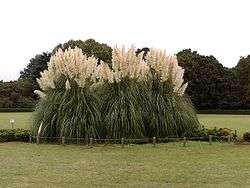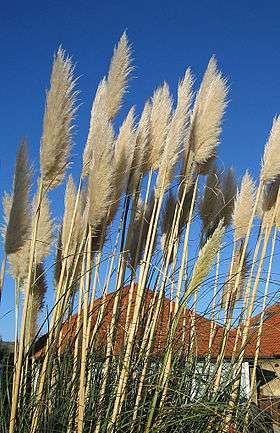Cortaderia selloana
| Pampas grass | |
|---|---|
 | |
| Pampas grass inflorescences | |
| Scientific classification | |
| Kingdom: | Plantae |
| (unranked): | Angiosperms |
| (unranked): | Monocots |
| (unranked): | Commelinids |
| Order: | Poales |
| Family: | Poaceae |
| Genus: | Cortaderia |
| Species: | C. selloana |
| Binomial name | |
| Cortaderia selloana (Schult. & Schult.f.) Asch. & Graebn. | |


Cortaderia selloana, commonly known as pampas grass,[1] is a flowering plant native to southern South America, including the Pampas region after which it is named. There are around 25 species in the genus Cortaderia.
It is a tall grass, growing in dense tussocks that can reach a height of 3 m (10 ft). The leaves are long and slender, 1–2 m (3 ft 3 in–6 ft 7 in) long, and 1 cm broad, with very sharp edges. The leaves are usually bluish-green, but can be silvery grey. The flowers are produced in a dense white panicle 20–40 cm (8–16 in) long on a 2–3 m (6 ft 7 in–9 ft 10 in) tall stem.
Cultivation and uses

The plant was introduced to Europe, North America, Australia and New Zealand as an ornamental grass, and, to a lesser extent, to provide food for grazing animals. The feathery flower head plumes, when dried, are widely used in flower arrangements and other ornamental displays.
Several cultivars are available, including:
- 'Albolineata'—a small cultivar which grows to only 2 m (6.6 ft) in height: The leaves are variegated, with yellow edges.
- 'Aureolineata' AGM[2]
- 'Pumila' AGM[3]
- 'Sunningdale Silver' AGM[4]—grows to a height of 4 m (13.1 ft) and has particularly dense flowering plumes
Those marked AGM have gained the Royal Horticultural Society's Award of Garden Merit.
Pampas grass is highly adaptable and can grow in a wide range of environments and climates. It also seeds prolifically, with each plant able to produce over one million seeds during its lifetime. As such, in some areas such as Florida, California, Hawaii and Spain it is regarded as an invasive weed. In areas of the southeastern United States, large pampas clumps are known to shelter snakes and rodents. In New Zealand, South Africa and Peninsular Spain, the plant is banned from sale and propagation. Burning pampas grass does not always kill it at the roots, but chemical weedkiller does.
Author Li Hengrui (李恒瑞), whose work Kite Capriccio (風箏暢想曲) describes life as a child in 1950s Fengtai County, Anhui mentions the use of the long stem of the Puwei (蒲葦, Chinese for Cortaderia selloana) in the construction of kites.[5]
It is planted by some couples who practise swinging (sexual practice) as a way to indicate to other swingers that they enjoy that lifestyle.[6][7]
Etymology
Cortaderia is derived from the Spanish-Argentinian name ‘cortadera’, meaning ‘cutter’, in reference to the sharp leaf margins.[8]
Selloana is named for Friedrich Sellow (1789-1831), a German botanist[8] and naturalist from Potsdam who worked as a plant collector in Brazil.[8] He studied the flora of South America, especially that of Brazil. The specific epithet selloana was given by Josef August and Julius Hermann Schultes in 1827.
References
- ↑ "BSBI List 2007". Botanical Society of Britain and Ireland. Archived from the original (xls) on 2015-01-25. Retrieved 2014-10-17.
- ↑ "Cortaderia selloana 'Aureolinata'". RHS Plant Selector. Retrieved 16 June 2013.
- ↑ "Cortaderia selloana 'Pumila'". RHS Plant Selector. Retrieved 16 June 2013.
- ↑ "Cortaderia selloana 'Sunningdale Silver'". RHS Plant Selector. Retrieved 16 June 2013.
- ↑ Putonghua Shuiping Ceshi Gangyao. 2004. Beijing. pp.350-351. ISBN 7-100-03996-7
- ↑ https://www.theguardian.com/lifeandstyle/shortcuts/2017/may/31/pampas-grass-secret-symbol-swingers-turn-off-sales-plummeting
- ↑ https://www.telegraph.co.uk/news/2017/05/30/exclusive-pampas-grass-sales-falling-secret-signal-swingers
- 1 2 3 Gledhill, David (2008). "The Names of Plants". Cambridge University Press. ISBN 9780521866453 (hardback), ISBN 9780521685535 (paperback). pp 122, 348
External links
| Wikimedia Commons has media related to Cortaderia selloana. |
| Wikispecies has information related to Cortaderia selloana |